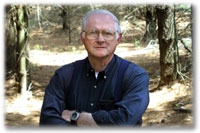Sunday, August 12, 2018
Lead Plant in the Prairie
A rather strange looking plant grows near the northwest corner of my prairie. It is too big for a wildflower, and too little to be a shrub. So I did a little research and discovered it is a leadplant. Scientific name: Amorpha canescens.
It gets its name from its lead-colored silver-gray leaves. Its flowers are purplish-orange and it blooms in July and August. It is one of our many native plants. The growing range for leadplant stretches from Canada to the Gulf of Mexico, right down the middle of the U.S., Canada to the north and Texas to the south. It will grow three feet tall on soil ranging from acidic, what I have, to soils somewhat alkaline. It is drought resistant and is a legume, which means it fixes nitrogen in the soil.
The early pioneers called this plant “ The Devil’s Shoestring” because of its tough root system which tangled their breaking plows. Of course the deep and tangled roots of the leadplant allow it to survive on droughty, sandy soils, which make up much of my farm.
Native Americans in the region knew about the leadplant and used it in many ways. They made tea from the leaves. Sometimes they drank the tea as a medicine to treat such health challenges as rheumatism and pinworms. They also put the leaves on open wounds. Some Native Americans believed that the smoke from burning leadplant leaves would attract buffalo to the person who had the smell of the smoke on their clothing.
Today, I enjoy looking at it and appreciate that I have this special plant growing in my prairie.
THE OLD TIMER SAYS: There is always something interesting to see in nature.
UPCOMING EVENTS:
--Sept 8. 10 a.m. Mt. Horeb Library, Once a Professor.
Purchase Jerry’s signed DVDs and books from the Library in Wild Rose, Wisconsin (a fundraiser for them):
Patterson Memorial Library
500 Division Street
Wild Rose, WI 54984
barnard@wildroselibrary.org
www.wildroselibrary.org
Phone: 920-622-3835
DVDs: His latest Public TV show, One-Room Country School is now available. It’s based on his book, One-Room Country Schools (also available). Emmy Winner, A Farm Winter with Jerry Apps (based on The Quiet Season book.)
Jerry Apps a Farm Story (based on Rural Wit and Wisdom and Old Farm books.)
The Land with Jerry Apps, (based on the book Whispers and Shadows,)
Never Curse the Rain, (based on his book with the same title)
The library has several of Jerry’s signed books for sale including Jerry’s newest nonfiction books, Once a Professor, Every Farm Tells a Story, Living a County Year (reprints), One-Room Country Schools, Never Curse the Rain and Old Farm Country Cookbook, and his novel, The Great Sand Fracas of Ames County. Also Wisconsin Agriculture: A History, Roshara Journal (with photos by Steve Apps) and Telling Your Story—a guidebook for those who want to write their own stories.
Contact the library for prices and special package deals.
A rather strange looking plant grows near the northwest corner of my prairie. It is too big for a wildflower, and too little to be a shrub. So I did a little research and discovered that it is a leadplant. Scientific name: Amorpha canescens.
It gets its name from its lead-colored silver-gray leaves. Its flowers are purplish-orange and it blooms in July and August. It is one of our many native plants. The growing range for leadplant stretches from Canada to the Gulf of Mexico, right down the middle of the U.S., Canada to the north and Texas to the south. It will grow three feet tall on soil ranging from acidic, what I have, to soils somewhat alkaline. It is drought resistant and is a legume, which means it fixes nitrogen in the soil.
The early pioneers called this plant “ The Devil’s Shoestring” because of its tough root system which tangled their breaking plows. Of course, the deep and tangled roots of the leadplant allow it to survive on droughty, sandy soils, which make up much of my farm.
Native Americans in the region knew about the leadplant and used it in many ways. They made tea from the leaves. Sometimes they drank the tea as a medicine to treat such health challenges as rheumatism and pinworms. They also put the leaves on open wounds. Some Native Americans believed that the smoke from burning leadplant leaves would attract buffalo to the person who had the smell of the smoke on their clothing.
Today, I enjoy looking at it and appreciate that I have this special plant growing in my prairie.
THE OLD TIMER SAYS: There is always something interesting to see in nature.
UPCOMING EVENTS:
--Sept 8. 10 a.m. Mt. Horeb Library, Once a Professor.
Purchase Jerry’s signed DVDs and books from the Library in Wild Rose, Wisconsin (a fundraiser for them):
Patterson Memorial Library
500 Division Street
Wild Rose, WI 54984
barnard@wildroselibrary.org
www.wildroselibrary.org
Phone: 920-622-3835
DVDs: His latest Public TV show, One-Room Country School is now available. It’s based on his book, One-Room Country Schools (also available). Emmy Winner, A Farm Winter with Jerry Apps (based on The Quiet Season book.)
Jerry Apps a Farm Story (based on Rural Wit and Wisdom and Old Farm books.)
The Land with Jerry Apps, (based on the book Whispers and Shadows,)
Never Curse the Rain, (based on his book with the same title)
The library has several of Jerry’s signed books for sale including Jerry’s newest nonfiction books, Once a Professor, Every Farm Tells a Story, Living a County Year (reprints), One-Room Country Schools, Never Curse the Rain and Old Farm Country Cookbook, and his novel, The Great Sand Fracas of Ames County. Also Wisconsin Agriculture: A History, Roshara Journal (with photos by Steve Apps) and Telling Your Story—a guidebook for those who want to write their own stories.
Contact the library for prices and special package deals.
Subscribe to:
Post Comments (Atom)


No comments:
Post a Comment